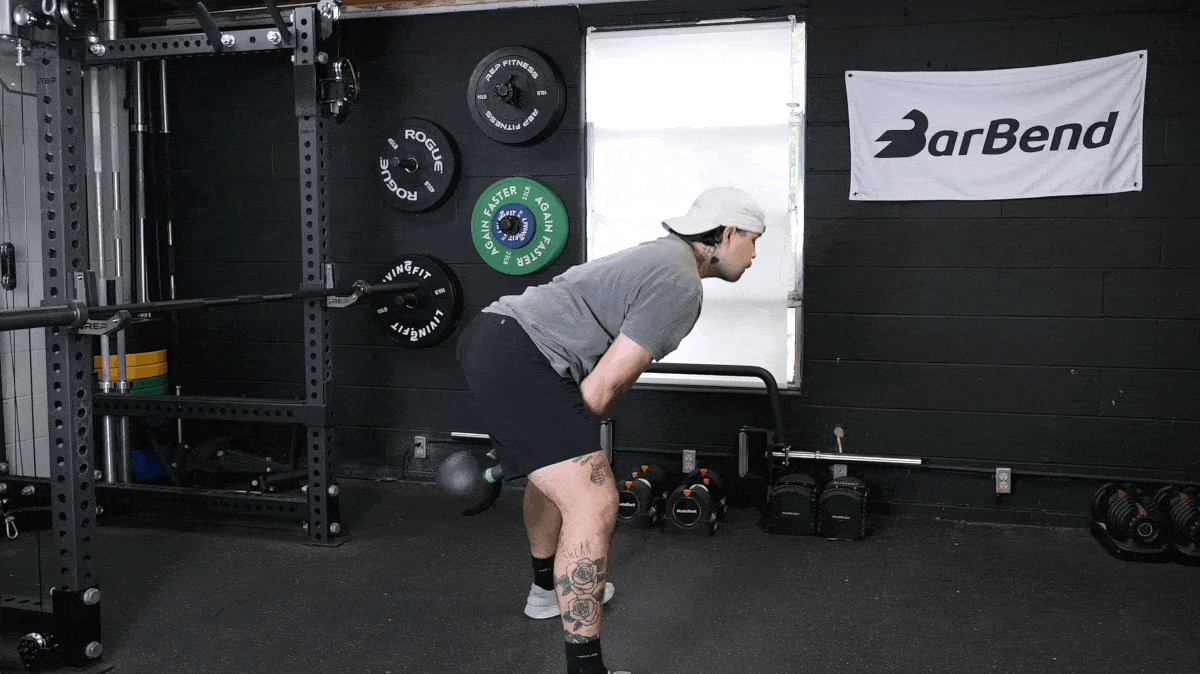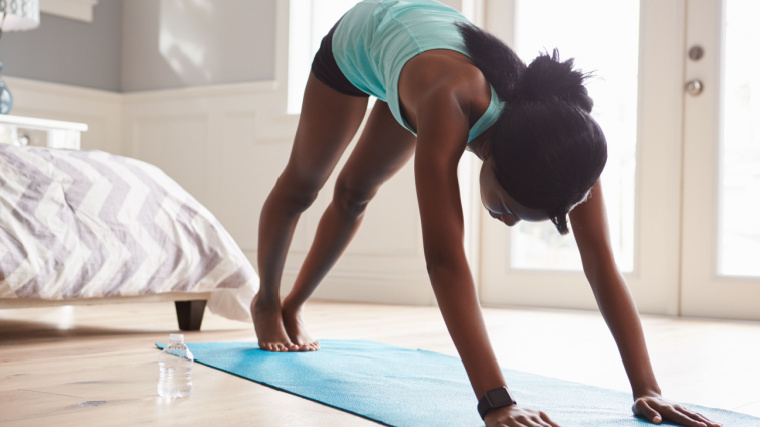When it comes to warm-up exercises and drills, the good ol’ KISS principle — that’s “keep it simple, stupid” — applies. Sure, there are times when you might need to break out a specific movement to tackle a nagging injury or warm-up a particularly stubborn joint before your exercise session.
But if you just need to break a sweat, get flexible, and prepare yourself for the workout to follow? Put the resistance bands back where you found them. Your body is a tool; use it like one. The inchworm exercise is your go-to all-in-one primer for functional, healthy movement.

Oh, and it has a slew of other benefits that make it a worthy inclusion into your training routine. Here’s how to do the inchworm exercise.
- How to Do the Inchworm
- Inchworm Variations
- Inchworm Alternatives
- Who Should Do the Inchworm
- Inchworm Sets and Reps
- Benefits of the Inchworm
- Muscles Worked by the Inchworm
- Common Inchworm Mistakes
- Frequently Asked Questions
How To Do the Inchworm
The inchworm is a simple, all-in-one dynamic bodyweight exercise that works as both a warm-up or a main movement in your workout plan. Here’s how to do it.
[Read More: The 20 Best Leg Exercises for Muscle and Strength]
- Step 1 — From an upright position, hinge over at the hips and reach down to the floor with your hands
- Step 2 — Place your palms on the floor in front of your feet, then slowly “walk” your hands out forward across the floor.
- Step 3 — Continue walking forward with straight legs until you come to a straight-armed plank position.
- Step 4 — From there, “walk” your feet up again towards your hands until you’re back in the starting position.
Inchworm Variations
Unfortunately, the inchworm isn’t the most customizable exercise out there. You can make some minor modifications to it, but there aren’t a wide variety of variations to the inchworm. Here are two options you can utilize with a resistance band:
Inchworm With Elbow Band
[Read More: The 12 Best Women’s Multivitamins]
- Fasten a thin band around your elbows, right above the joint on your upper arm.
- Then, perform the inchworm as you normally would, actively contracting your upper back to place mild tension across the band by deliberately spreading your arms.
Inchworm With Knee Band
- Fasten a thin band around your knees, above the joint on your lower thigh.
- Then, perform the inchworm as you typically would. Contract your glutes to gently push your knees outward and apply tension to the band.
Inchworm Alternatives
The inchworm is great for mobilizing your posterior chain, taxing your core, and testing your shoulder stability all at once. While the dynamic nature of the movement makes it hard to capture all of those benefits at once, you can try some of these inchworm alternatives and get a similar result:
Kettlebell Swing

[Read More: The 12 Best Supplements for Muscle Growth]
- Stand upright holding the handle of a kettlebell in both hands with a slightly-wider-than-hip-width stance.
- Hinge at the hips and allow the kettlebell to swing backward between your legs as you tip over.
- Thrust your hips forward aggressively and let the momentum carry the bell out in front of your body.
- Once the bell reaches its apex, let it fall naturally and return to a hinged position, sweeping it back between your legs once again.
- Get into a rhythm and let the force from your hips repeatedly swing the kettlebell back and forth.
Hanging Leg Raise
[Read More: The 15 Best Upper Ab Exercises for a Stronger Core]
- Find a pull-up bar and hang freely from it with a shoulder-width grip.
- With straight legs, contract your core and flex your abs to raise your legs up and forward until they’re at least parallel to the ground.
- Hold for a beat at the top and then reverse the motion.
Who Should Do the Inchworm
The inchworm is a versatile movement in its own right. You can plug it into the start of your warm-up routine and it’ll benefit the forthcoming workout no matter what you’re training for. If you fall into one of the following categories, consider giving the inchworm a go:
CrossFitters
CrossFit workouts contain a wide array of different exercises and movement patterns. As such, your warm-up should be both dynamic and specific to the task at hand. You need a mobile posterior chain, activated core, and flexible shoulders for almost every CrossFit or functional fitness training session.
Strength Athletes
Strength training may entail lifting heavy weights, but you shouldn’t just stroll into the gym and head right to the squat rack. A good warm-up can prime you for optimal performance with the barbell, and that starts by raising your core temperature and mobilizing your joints.
Try the inchworm out for a few sets before a bodyweight deadlift workout and you should find things move a bit smoother and the relevant musculature is more engaged than if you had simply spent 10 minutes on the treadmill.
If You Work Out at Home
One of the biggest drawbacks of home workouts is that you’re limited in your exercise selection by the equipment you have on-hand. You’ll usually need to get creative with your calisthenics training and employ bodyweight moves like the inchworm instead.
[Read More: The 15 Best Home Gyms]
The inchworm works your core, shoulders, and posterior chain — all of which can sometimes be difficult to target with typical home fitness equipment like dumbbells or resistance bands.
Inchworm Sets and Reps
As the inchworm is a bodyweight-only movement, you can’t really approach it with the same set-and-rep scheme as you would for weighted exercises. However, there are a few different ways you can utilize it to your advantage:
- To Warm Up: Try 3 rounds of 5 inchworms back-to-back.
- As a Cool-Down: Do 3 rounds of 3 inchworms with a slow tempo, really taking your time to stretch out the relevant muscles.
Benefits of the Inchworm
The inchworm has a surprising amount of utility. You can use it to warm-up, to get a quick stretch in while you’re traveling, or as part of your accessory or cool-down routine.
Full-Body Flexibility
The inchworm is rare in its ability to mobilize both your upper and lower body simultaneously. Bending over to touch the floor and walk your hands out will lengthen your hamstrings and lumbar spine, while moving into the straight-arm plank will stretch out your shoulders.

[Read More: The 16 Best Pre-Workout Supplements]
This makes the inchworm a fantastic warm-up drill ahead of a full-body workout where you’re using multiple joints at once.
It Has a Simple Technique
You can’t underestimate the value of a bodyweight mobility drill that has an intuitive, straightforward technique. The inchworm can be learned in just a few minutes, making it a great plug-and-play option. When you’re in a hurry, you need movements that you can pick up and utilize right away instead of spending multiple sessions mastering the technique in the first place.
Versatility
As your fitness goals evolve and change, your workouts should progress as well. This usually means adjusting your accessory routine or dynamic warm-up exercises, but you don’t have to remove the inchworm along the way.
Because of its wide-ranging applicability and ease of access, you can use the inchworm for just about any fitness goal in the right context. It works as a standalone movement to mobilize your joints or as a primer before more specific training like powerlifting or gymnastics.
Muscles Worked by the Inchworm
The inchworm works just about every muscle in your body to some degree. Here are the major muscle groups that are most relevant when you perform the exercise:
Core
As you walk your hands out in the inchworm, your core bears more and more load until you’re in the straight-armed plank position. This taxes your abdominals isometrically. Your abs work on some level to stabilize your trunk for the entire duration of the inchworm.
Shoulders
As you descend into the inchworm, your arms gradually move upward until they’re in line with your torso. This motion is called shoulder flexion, and will tax the tissues around your shoulder blade, forcing them to relax and open up. This makes the inchworm a great way to improve your overhead mobility before a pressing workout or if you feel tight or restricted in your thoracic region.
Hamstrings
The inchworm exercise involves lengthening the muscles in your posterior chain. Principally, your hamstrings, which run from your shin bone across your knee and hip and attach onto your pelvis.

[Read More: The Best Quad Exercises and Quad Workouts for Muscle Gain]
Tight hamstrings can inhibit all kinds of movement in certain situations. The inchworm serves as a low-intensity way of opening up your posterior chain ahead of a workout that requires you to use those muscles through their full range of motion.
Common Inchworm Mistakes
The inchworm may be less complex than, say, a snatch or overhead squat, but that doesn’t mean there aren’t still mistakes you can make along the way. Steer clear of these common errors:
Bending Your Legs
The inchworm works as a posterior chain lengthener, but only if you can maintain a straight leg throughout the first portion of the movement. You’ll have to bend your knees a bit to walk your feet up towards your hands in the second half, but in the first phase of the movement try to keep your knees as straight as possible.
Rushing Your Movement
This movement is equal parts dynamic warm-up drill and active stretch — the worst thing you can do is rush through the inchworm and execute it with poor form. You won’t be at any risk of injury by doing so, but you should really take your time and feel your body stretching out as you move through the drill if you want to reap the maximum benefits from it.
More Training Content
- How to Do the Kettlebell Halo for a Stronger Core and Better Shoulder Mobility
- The Only Bulking Workout Plan You Need to Build Muscle ASAP
- How to Lose Weight Fast, According to Science
FAQs
Does the inchworm have you all knotted up? No worries. Here are some common questions about the exercise and their answers.
What is the inchworm exercise good for?
The inchworm exercise is a dynamic warm-up and mobility tool. Most people use it to stretch out the muscles in their posterior chain ahead of a hard workout, or after bouts of travel.
Is the inchworm a full-body exercise?
For the most part, yes. The inchworm will activate the muscles in the backs of your legs, your torso, your shoulders, and your core primarily.
What muscles does the inchworm crawl work?
Doing the inchworm will work your shoulders, core, and posterior chain through a large portion of their range of motion, making it a fantastic full-body movement.
Featured Image: Dusan Petkovic / Shutterstock